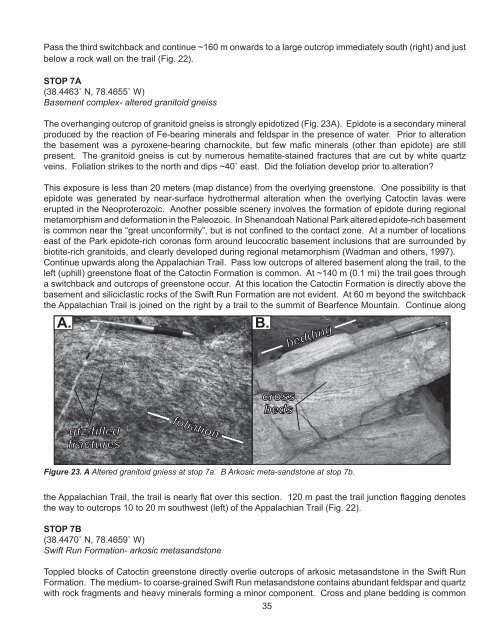Geology of the Shenandoah National Park Region - Csmres Jmu ...
Geology of the Shenandoah National Park Region - Csmres Jmu ...
Geology of the Shenandoah National Park Region - Csmres Jmu ...
Create successful ePaper yourself
Turn your PDF publications into a flip-book with our unique Google optimized e-Paper software.
Pass <strong>the</strong> third switchback and continue ~160 m onwards to a large outcrop immediately south (right) and just<br />
below a rock wall on <strong>the</strong> trail (Fig. 22).<br />
STOP 7A<br />
(38.4463˚ N, 78.4655˚ W)<br />
Basement complex- altered granitoid gneiss<br />
The overhanging outcrop <strong>of</strong> granitoid gneiss is strongly epidotized (Fig. 23A). Epidote is a secondary mineral<br />
produced by <strong>the</strong> reaction <strong>of</strong> Fe-bearing minerals and feldspar in <strong>the</strong> presence <strong>of</strong> water. Prior to alteration<br />
<strong>the</strong> basement was a pyroxene-bearing charnockite, but few mafic minerals (o<strong>the</strong>r than epidote) are still<br />
present. The granitoid gneiss is cut by numerous hematite-stained fractures that are cut by white quartz<br />
veins. Foliation strikes to <strong>the</strong> north and dips ~40˚ east. Did <strong>the</strong> foliation develop prior to alteration?<br />
This exposure is less than 20 meters (map distance) from <strong>the</strong> overlying greenstone. One possibility is that<br />
epidote was generated by near-surface hydro<strong>the</strong>rmal alteration when <strong>the</strong> overlying Catoctin lavas were<br />
erupted in <strong>the</strong> Neoproterozoic. Ano<strong>the</strong>r possible scenery involves <strong>the</strong> formation <strong>of</strong> epidote during regional<br />
metamorphism and deformation in <strong>the</strong> Paleozoic. In <strong>Shenandoah</strong> <strong>National</strong> <strong>Park</strong> altered epidote-rich basement<br />
is common near <strong>the</strong> “great unconformity”, but is not confined to <strong>the</strong> contact zone. At a number <strong>of</strong> locations<br />
east <strong>of</strong> <strong>the</strong> <strong>Park</strong> epidote-rich coronas form around leucocratic basement inclusions that are surrounded by<br />
biotite-rich granitoids, and clearly developed during regional metamorphism (Wadman and o<strong>the</strong>rs, 1997).<br />
Continue upwards along <strong>the</strong> Appalachian Trail. Pass low outcrops <strong>of</strong> altered basement along <strong>the</strong> trail, to <strong>the</strong><br />
left (uphill) greenstone float <strong>of</strong> <strong>the</strong> Catoctin Formation is common. At ~140 m (0.1 mi) <strong>the</strong> trail goes through<br />
a switchback and outcrops <strong>of</strong> greenstone occur. At this location <strong>the</strong> Catoctin Formation is directly above <strong>the</strong><br />
basement and siliciclastic rocks <strong>of</strong> <strong>the</strong> Swift Run Formation are not evident. At 60 m beyond <strong>the</strong> switchback<br />
<strong>the</strong> Appalachian Trail is joined on <strong>the</strong> right by a trail to <strong>the</strong> summit <strong>of</strong> Bearfence Mountain. Continue along<br />
A.<br />
qtz-filled<br />
fractures<br />
foliation<br />
<strong>the</strong> Appalachian Trail, <strong>the</strong> trail is nearly flat over this section. 120 m past <strong>the</strong> trail junction flagging denotes<br />
<strong>the</strong> way to outcrops 10 to 20 m southwest (left) <strong>of</strong> <strong>the</strong> Appalachian Trail (Fig. 22).<br />
STOP 7B<br />
(38.4470˚ N, 78.4659˚ W)<br />
Swift Run Formation- arkosic metasandstone<br />
Toppled blocks <strong>of</strong> Catoctin greenstone directly overlie outcrops <strong>of</strong> arkosic metasandstone in <strong>the</strong> Swift Run<br />
Formation. The medium- to coarse-grained Swift Run metasandstone contains abundant feldspar and quartz<br />
with rock fragments and heavy minerals forming a minor component. Cross and plane bedding is common<br />
B.<br />
cross<br />
beds<br />
35<br />
bedding<br />
Figure 23. A Altered granitoid gniess at stop 7a. B Arkosic meta-sandstone at stop 7b.


